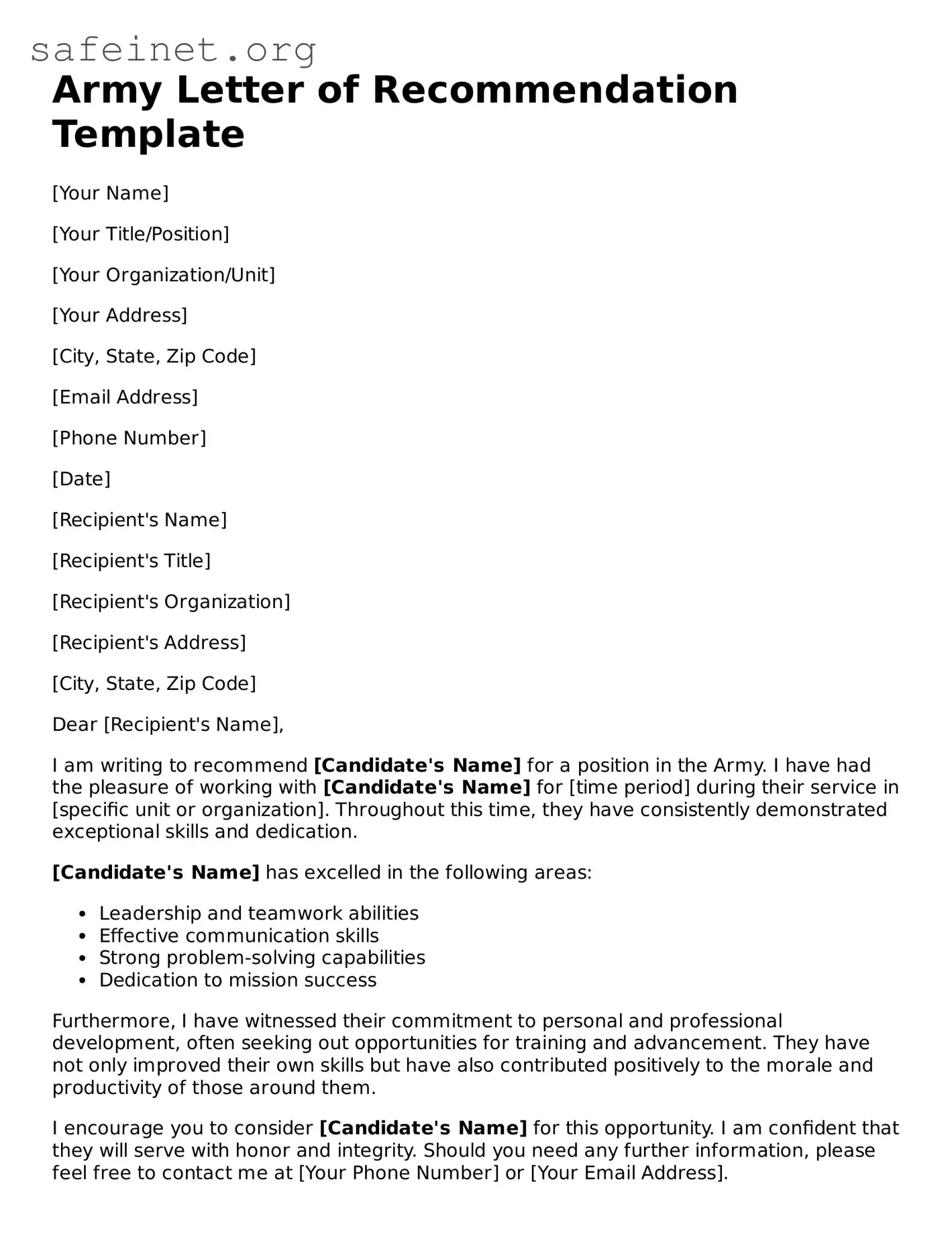The Army Letter of Recommendation form shares similarities with the General Letter of Recommendation. Both documents serve the purpose of endorsing an individual's skills and qualities, providing insight into their character. A General Letter of Recommendation can support applications for jobs, college admissions, or scholarships, much like the Army version is used to bolster military applications or promotions. Each document is typically tailored to highlight specific strengths relevant to the opportunity in question, enhancing the candidate's profile.
Another document akin to the Army Letter of Recommendation is the Performance Evaluation Report. While the Army letter focuses more on personal endorsement, the Performance Evaluation Report is a structured assessment of an individual's work and achievements within the military. Both documents assess qualities such as leadership, teamwork, and dedication, which are vital for understanding a servicemember's capabilities and potential for advancement.
The College Admission Letter of Recommendation also bears resemblance to the Army form. Both documents aim to showcase the applicant's strengths and accomplishments. In the context of college admissions, the recommendation emphasizes academic performance and extracurricular involvement. Similarly, the Army letter highlights leadership experiences and military values, both of which are crucial in evaluating the individual’s preparedness for their next opportunity.
The Professional Reference Letter is another comparable document. This letter functions as a referral for potential employment or projects. Like the Army Letter of Recommendation, it focuses on relevant skills, work ethic, and character traits. Both types of letters are intended to reassure a potential employer or reviewer of the individual's qualifications and to substantiate their application with supportive assessments from trusted individuals.
A Fellowship Recommendation Letter shares key characteristics with the Army Letter of Recommendation. Both documents aim to validate the applicant’s qualifications for a specific role or opportunity. A fellowship letter usually emphasizes academic achievements, research skills, and community involvement, while the Army version focuses on leadership and military experiences. The underlying goal of both is to provide a compelling case for why the individual deserves the opportunity they are pursuing.
The Scholarship Recommendation Letter is similar in intent to the Army Letter of Recommendation. Both documents serve to persuade a selection committee or authority that a candidate possesses the necessary qualities to deserve financial support. The Scholarship Recommendation Letter often highlights a student's academic performance and potential, while the Army letter emphasizes a candidate's military service and accomplishments, underscoring their leadership potential and commitment.
The Civil Service Reference Letter parallels the Army Letter of Recommendation in its function as a recommendation for securing a position in government roles. Each document validates the applicant's qualifications, focusing on their experience and character attributes relevant to the respective fields. Highlighting integrity and professionalism is essential in both contexts, ensuring the candidate is seen as a suitable fit for the responsibilities of a civil service position or a military role.
The Letter of Intent can also be considered similar to the Army Letter of Recommendation. While the Army letter provides endorsements, a Letter of Intent outlines an individual's goals and ambitions. Nevertheless, both documents seek to establish a connection between the individual and the institution or opportunity being pursued. When applicants express their intentions with clear examples of their capabilities, they strengthen the case for their candidacy.
Lastly, the Supervisor Recommendation Letter shares a common purpose with the Army Letter of Recommendation. This letter is typically written by a direct supervisor, emphasizing the employee’s strengths and contributions. Both forms highlight reliability, work ethic, and collaboration, allowing potential employers or boards to see the individual’s values and work impact within a structured environment. This connection to leadership and performance makes both documents crucial in showcasing an individual's suitability for future roles.
